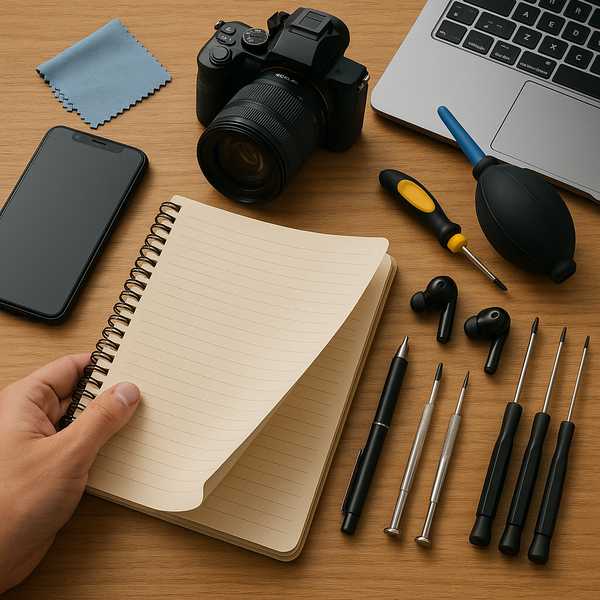
Keeping your electronic gadgets running smoothly doesn't require a degree in engineering. In fact, performing simple, regular maintenance can significantly extend their lifespan, improve performance, and prevent costly repairs down the line. This guide will walk you through easy steps you can take today to care for your smartphones, laptops, tablets, and other essential devices, ensuring they stay in top condition.
Why Regular Maintenance Matters
Think of your gadgets like a car or even your own body; neglect leads to problems. Dust, dirt, and debris can accumulate in ports and vents, causing overheating and performance slowdowns. Software issues like outdated operating systems and cluttered storage can make your devices sluggish or prone to crashes. Battery health degrades over time if not properly managed. Ignoring these small issues can lead to bigger, more expensive problems, or even the premature death of your device. Simple maintenance isn't just about cleaning; it's about proactive care that saves you time, money, and frustration in the long run.
Essential Cleaning Techniques
Physical cleanliness is fundamental. Start with the screen. Use a microfiber cloth specifically designed for electronics. Avoid harsh chemicals or paper towels, which can scratch the display. For stubborn smudges, lightly dampen the cloth with water or a specialized screen cleaner, but never spray liquid directly onto the screen or device.
Ports and buttons are dust magnets. For USB, charging, or headphone ports, a can of compressed air is your best friend. Use short bursts to blow out debris. Be gentle with buttons and switches; a soft brush or cotton swab can help remove grime around them.
Keyboards on laptops or external keyboards can harbor a surprising amount of dirt and germs. Turn the keyboard upside down and gently shake to dislodge loose particles. Use compressed air between the keys. For surface cleaning, a slightly damp cloth or a cleaning wipe designed for electronics can work, but ensure no liquid drips into the device.
Device exteriors also need attention. A gentle wipe-down with a microfiber cloth can keep the body of your phone, tablet, or laptop looking new and free from sticky residue or fingerprints. Always power down your device before cleaning, especially when dealing with ports or intricate areas.
Software Housekeeping for Optimal Performance
Beyond physical cleaning, software maintenance is crucial. The most important step is keeping your operating system (OS) and apps updated. Updates often contain performance improvements, security patches, and bug fixes that are vital for smooth operation and protecting your data. Enable automatic updates whenever possible.
Storage management is another key area. Over time, your device accumulates temporary files, cache data, and apps you no longer use. Regularly clearing app caches (within app settings or device storage settings) and deleting unnecessary apps, photos, videos, and documents can free up significant space and speed up your device. Consider using cloud storage or external drives for backups to keep your device's internal storage lean.
Regularly restarting your device can also work wonders. It clears temporary memory, closes unnecessary background processes, and can resolve minor software glitches that accumulate over time. Make it a habit to restart your phone or laptop at least once a week.
Battery Health: Tips for Longevity
Batteries are consumable components that degrade over time, but proper care can slow this process. Avoid exposing your device to extreme temperatures, hot or cold, as this can significantly damage the battery. While modern batteries are designed to be charged whenever convenient, avoiding constantly draining the battery to 0% or keeping it plugged in at 100% for extended periods (like overnight, every night) is often recommended by manufacturers. Many devices now have optimized charging features that learn your habits and manage charging to reduce battery strain.
Using the correct charger is also important. Always use the original charger or a reputable, certified third-party charger to ensure your device receives the correct power flow.
Troubleshooting Common Issues
Many common gadget problems can be fixed with simple steps. If an app is misbehaving, try force-closing it and reopening. If the device is slow, try restarting it. If Wi-Fi or Bluetooth isn't connecting, toggle the setting off and on, or restart the device and the router/accessory. For many software issues, a quick online search for the specific problem and device model can yield simple DIY fixes from forums or official support pages.
Always back up your data regularly! Whether it's using cloud services, computer backups, or external drives, having a recent backup means you won't lose precious photos, documents, or contacts if something goes wrong during troubleshooting or if the device fails.
Knowing When to Seek Professional Help
While simple maintenance and troubleshooting can fix many issues, some problems require expert attention. If your device has physical damage (cracked screen, liquid spill), significant hardware malfunction (won't turn on, port damage, speaker issues), or if you've tried basic fixes for a software issue without success, it's time to consider professional repair services. Attempting complex repairs yourself without the right tools or knowledge can cause further, irreparable damage. Research reputable local repair shops or authorized service centers for your device's brand.
Maintaining your gadgets doesn't have to be a chore. Incorporating these simple practices into your routine can dramatically improve their performance, extend their life, and save you the hassle and expense of dealing with major malfunctions. A little care goes a long way in keeping your essential tech running smoothly.

